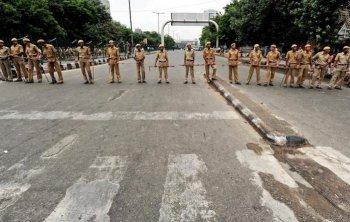BANGALORE, India—This Wednesday marked the end of the monsoon season in India with rain at the lowest in 40 years, according to the meteorological department.
Monsoons, though they can be potentially destructive, are welcomed in India to sustain the economy. Farmers rely on the rains to irrigate the land, while much of India’s electricity is generated by water power provided by the monsoons rains.
Officials agree that the weak monsoons, 36 percent below normal in Northwest regions, are already having a negative effect on the overall economy, with prices of basic food items skyrocketing.
Though Prime Minister Manmohan Singh has already stated that there are enough food reserves to stave off widespread hunger, this does little to reassure farmers who depend on the rain for their livelihood, like Shree Ram Reddy in Srinivaspur, Kolar, Karataka.
The farmers in his district depend on bore wells for irrigation. Sixty percent of the wells have dried up, and all the tanks are empty. “The rain here has been untimely,” he said. “When the seeds were sown and we most needed the rains, the rains did not come. But two months later there were rains which caused some losses.”
As a result of the weak rain, inflation shot up to 4.8 percent in November, an increase from 1.3 percent in October. Food costs went up by 19 percent, creating major hardship for citizens. What used to cost $1 for dal, a food staple, now costs $2. Prices of other food items, like sugar, have also gone up.
The government is trying to help with a scheme that gives jobs to farmers who have lost their livelihoods, but the uptake so far hasn’t been great.
Reddy’s production is down 50 percent, and he and his neighbors are feeling the hurt. “There is a financial crisis as well for the farmers. Overall the situation is very bad.”
Alongside this are estimates that India wastes around $50 billion worth of grains every year due to lack of post-harvest infrastructure, like appropriate storage facilities.
Monsoons, though they can be potentially destructive, are welcomed in India to sustain the economy. Farmers rely on the rains to irrigate the land, while much of India’s electricity is generated by water power provided by the monsoons rains.
Officials agree that the weak monsoons, 36 percent below normal in Northwest regions, are already having a negative effect on the overall economy, with prices of basic food items skyrocketing.
Though Prime Minister Manmohan Singh has already stated that there are enough food reserves to stave off widespread hunger, this does little to reassure farmers who depend on the rain for their livelihood, like Shree Ram Reddy in Srinivaspur, Kolar, Karataka.
The farmers in his district depend on bore wells for irrigation. Sixty percent of the wells have dried up, and all the tanks are empty. “The rain here has been untimely,” he said. “When the seeds were sown and we most needed the rains, the rains did not come. But two months later there were rains which caused some losses.”
As a result of the weak rain, inflation shot up to 4.8 percent in November, an increase from 1.3 percent in October. Food costs went up by 19 percent, creating major hardship for citizens. What used to cost $1 for dal, a food staple, now costs $2. Prices of other food items, like sugar, have also gone up.
The government is trying to help with a scheme that gives jobs to farmers who have lost their livelihoods, but the uptake so far hasn’t been great.
Reddy’s production is down 50 percent, and he and his neighbors are feeling the hurt. “There is a financial crisis as well for the farmers. Overall the situation is very bad.”
Alongside this are estimates that India wastes around $50 billion worth of grains every year due to lack of post-harvest infrastructure, like appropriate storage facilities.



